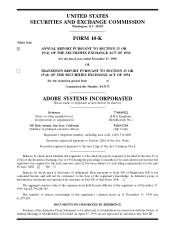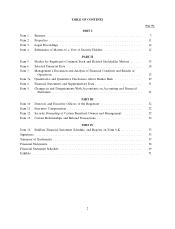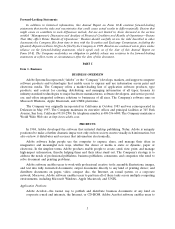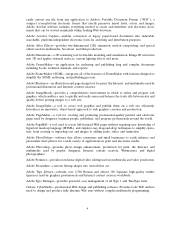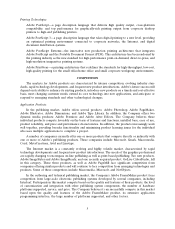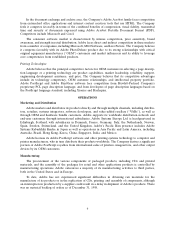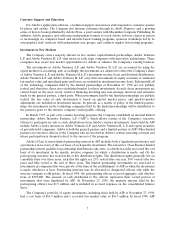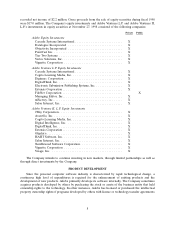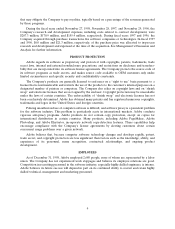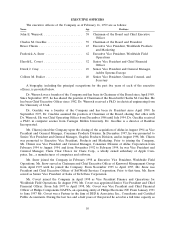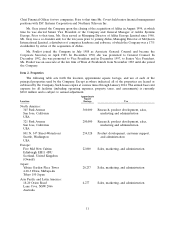Adobe 1998 Annual Report Download - page 6
Download and view the complete annual report
Please find page 6 of the 1998 Adobe annual report below. You can navigate through the pages in the report by either clicking on the pages listed below, or by using the keyword search tool below to find specific information within the annual report.In the document exchange and archive area, the Company’s Adobe Acrobat family faces competition
from entrenched office applications and internet content creation tools that use HTML. The Company
feels it competes favorably in terms of the combined benefits of compression, visual fidelity, transmittal
time and security of documents expressed using Adobe Acrobat Portable Document Format (PDF).
Competitors include Microsoft and Corel.
The consumer software market is characterized by intense competition, price sensitivity, brand
awareness, and strength in retail distribution. Adobe faces direct and indirect competition in these markets
from a number of companies, including Microsoft, MGI Software, and Live Picture. The Company believes
it competes favorably with its Adobe PhotoDeluxe product due to its strong relationships with critical
original equipment manufacturer (‘‘OEM’’) customers and market influencers and its ability to leverage
core competencies from established products.
Printing Technologies:
Adobe believes that the principal competitive factors for OEM customers in selecting a page descrip-
tion language or a printing technology are product capabilities, market leadership, reliability, support,
engineering development assistance, and price. The Company believes that its competitive advantages
include its technology competency, OEM customer relationships, and intellectual property portfolio.
Adobe PostScript and Adobe PrintGear software face competition from Hewlett-Packard Company’s
proprietary PCL page description language, and from developers of page description languages based on
the PostScript language standard, including Xionics and Harlequin.
OPERATIONS
Marketing and Distribution
Adobe markets and distributes its products directly and through multiple channels, including distribu-
tors, retailers, systems integrators, software developers, and value-added resellers (‘‘VARs’’), as well as
through OEM and hardware bundle customers. Adobe supports its worldwide distribution network and
end-user customers through international subsidiaries. Adobe Systems Europe Ltd. is headquartered in
Edinburgh, Scotland, with subsidiaries in Denmark, France, Germany, Italy, the Netherlands, Norway,
Spain, Sweden, Switzerland, and the United Kingdom. Adobe’s Pacific Rim presence includes Adobe
Systems Kabushhiki Kaisha in Japan as well as operations in Asia Pacific and Latin America, including
Australia, Brazil, Hong Kong, Korea, China, Singapore, India, and Mexico.
Adobe licenses its Adobe PostScript software and other printing systems technology to computer and
printer manufacturers, who in turn distribute their products worldwide. The Company derives a significant
portion of Adobe PostScript royalties from international sales of printers, imagesetters, and other output
devices by its OEM customers.
Manufacturing
The procurement of the various components of packaged products, including CDs and printed
materials, and the assembly of the packages for retail and other applications products is controlled by
manufacturing operations. Adobe outsources a majority of its manufacturing activities to third parties,
both in the United States and in Europe.
To date, Adobe has not experienced significant difficulties in obtaining raw materials for the
manufacture of its products or in the replication of CDs, printing, and assembly of components, although
an interruption in production by a supplier could result in a delay in shipment of Adobe’s products. There
was no material backlog of orders as of December 31, 1998.
6

